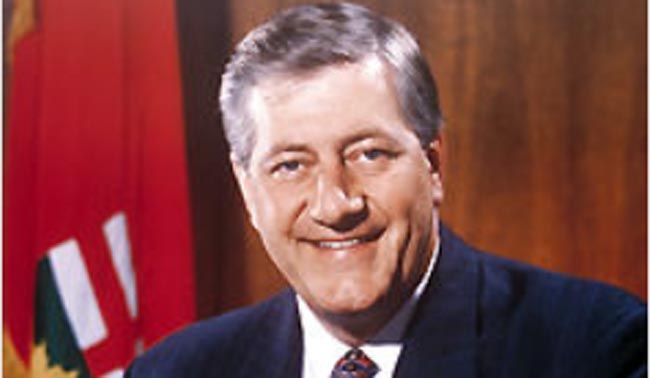The Mike Harris ‘common sense revolution’ discussed at legacy event

By Marci Becking
NORTH BAY – Nipissing First Nation councillor Arnold May recalled some memorable Mike Harris moments and the impacts on his community at the Sept. 27 Mike Harris Legacy event held at the Harris Learning Library.
“I want to go back to 1985,” said May of Harris’ time as the Minister of Natural Resources. “He saw fit at that time to install hidden cameras on telephone poles in our community in an effort to try to catch our fisherman selling fish. There were 122 charges laid at that time. During our community meetings, they had helicopter patrolling the shore line between North Bay and Garden Village. One of our community members did go to court – he won his case and all the other 121 charges were dropped.”
May left the rest of the impacts of the Mike Harris Legacy up to the three panelists of A Public Talk in Three Parts hosted by Nipissing University history professor Dr. Catherine Murton Stoehr. The aim of the event was to have a conversation to see where the province was and where it is today.
Maurice Switzer, First Nations public education consultant and co-organizer of the event said he remembered exactly where he was when he heard that unarmed protest Dudley George had been killed by an OPP officer at the former Ipperwash Provincial Park in 1995. It was the first time since the 1800s that anyone knew of a First Nations person who was killed in a land claim.
“At the Ipperwash Inquiry, all Dudley’s brother Sam George wanted to know is ‘Why did this happen?’” recalled Switzer of the inquiry. “It was the first time a provincial premier was called to testify in involving the death of a First Nations person. Harris was defiant, not remorseful – he was just the furthest thing that I can imagine anybody being whose action could be seen to lead to anyone’s death. The lawyer’s went at him and he refused to show any humility.”
Switzer spoke of the death of social assistance recipient, Kimberly Rogers who died in her apartment while under house arrest in Sudbury. She had used some of her social assistance money to pay for college tuition and better herself.
“And the seven people who died in Walkerton because Mike Harris thought that we didn’t need much regulation on something like drinking water. Nine deaths. Nine that we know of,” said Switzer.
John Stapleton and Ontario Social Assistance Policy Analyst showed graphs and charts to participants of what social assistance looked before the Harris years and how the changes he implemented and how they impacted Ontario residents.
Stapleton pointed out that the depression of the early 1990s resembled that of the Great Depression of the 1930s. Due to cuts to social assistance after 1995, many families had to decide whether to heat their home or put food on the table.
“One of his first major policy decisions in 1995 was to cut social assistance rates by 22%,” said Stapleton. “There were also more single parent families on social assistance in the mid to late 90s.
The Harris government introduced Ontario Works – commonly referred to as workfare. Stapleton says that there was a jealousy of time of those who were on social assistance and the mindset was that able-bodied people should either be volunteering, training or have job placements.
Neil Munro, former president of the Ontario Secondary School Teachers Federation representing District 4 spoke about the affects of the Mike Harris years on education in Ontario, including curriculum.
“They wanted our students to work harder. It was like trying to fit four litres of water into a three litre container,” says Munro. “Still to this day, teachers have to decide what 25-30 per cent of the course content they’re going to leave out or teach everything at break-neck speed and hope that the students can keep up. Of course, different parts of the 30 per cent are left out.”
The event was held at the same time Mike Harris was recognized at the Kiwanis Nipissing Walk of Fame Dinner.


